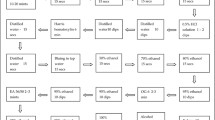Abstract
Objectives
To determine the prevalence of clue cells suggestive for Gardnerella vaginalis in population-based cervical screening in the public (SUS) versus private (RP) health care utilization in Maringá, Paraná, Brazil.
Methods
A retrospective study on the results of 133,966 cytology examinations of patients from the Brazilian Public Health System-SUS (better socio-economic status-SES) and from the Private Network-RP (low SES) done by the Souza Anatomy Laboratory in Maringá, Brazil, from 2004 to 2007.
Results
In patients using the SUS, the prevalence of clue cells was 6.75% (n = 3,573), higher (p < 0.05) than for RP users (3.53%, n = 2,813). The clue cells predominated in age range of the 20–49 years from the SUS and RP (p > 0.05). In both the populations, the prevalence and age range did not vary among the 4 years (p > 0.05) and the prevalence declines in age above 45 years (p < 0.05).
Conclusions
The prevalence of clue cells was low and stable in both populations in the 4 years, indicating equilibrium in terms of numbers of bacterial vaginosis (BV) in this localization. The results indicate that SES may influence the epidemiology of BV and that the prevalence declines expressively in older women.


Similar content being viewed by others
References
Davis JD, Connor EE, Clark P, Wilkinson EJ, Duff P (1997) Correlation between cervical cytologic results and gram stain as diagnostic tests for bacterial vaginosis. J Obstet Gynecol 177:532–535
Lipsky MS, Waters T, Sharp LK (2000) Impacto of antifungal products on utilization of health care services; evidence from physician visits. J Am Board Fam Prat 13:178–182
Nyirjessy P (2008) Vulvovaginal candidiasis and bacterial vaginosis. Infect Dis Clin N Am 22:637–652
Lippman AS, Jones HE, Luppi CG, Pinho AA, Veras MAMS, Van de Wijgert JHHM (2007) Home-based self-sampling and self-testing for sexually transmitted infections: acceptable and feasible alternatives to provider-based screening in low-income women in São Paulo, Brazil. Sex Transm Dis 34:421–428
Klomp JM, Boon ME, Van Haaften M, Heintz PM (2008) Cytologically diagnosed Gardnerella vaginalis infection and (pre) neoplasia as established in population-based cervical screening. Am J Obst Gynecol 199:480–485
Lamont RF, Hudson EA, Hay PE, Morgan DJ, Modi V, Ison CA, Taylor RD (1999) A comparison of the use of Papanicolaou-stained cervical cytological smears with Gram-stained vaginal smears for the diagnosis of bacterial vaginosis in early pregnancy. Int J STD AIDS 10:93–97
Morales WJ, Scherr S, Albritten (1994) Effect of metronidazol in patients with preterm birth in preceding pregnancy and bacterial vaginaosis: a placebo-controlled, double-blind study. Am J Obstet Gynaecol 171:345-349
Warren D, Lein RS, Sobel J, Kieke B Jr, Brown W, Schuman P (2001) HIV Epidemiology Research Study Group. A multicenter study of bacterial vaginosis in women with or at risk for HIV infection. Infect Dis Obst Gynecol 9:133–141
Avilés AGP, Zaragoza CO, Barrera LT, Mota-Vasquez R, Rosas RP (2001) Es útil la tinción de Papanicolaou como auxiliar del diagnostico de algunas infecciones de transmisión sexual? Atenc Prim 27:222–226
Solomon D, Nayar R (2005) Sistema Bethesda para citopatologia cervicovaginal. Definições, critérios e notas explicativas. Revinter, Rio de Janeiro
Meisels A, Morin C (2007) Modern uterine cytopathology: moving to the molecular smear. ASCP Press, Chicago
Pundel JP, Lichtfus C (1957) Modification de la coloration cytologique des frottis vaginaux à I’hématoxiline-Shorr. Gynaecology 44:58
Amaral RG, Santos SHR, Catharino JMR, Silva LCB, Westin MCA, Cotta AN et al (2003) Rapid screening of cervical smears as a method of internal quality assurance. J Bras Patol Med Lab 39:151–155
Allsworth JE, Peipert JF (2004) Prevalence of bacterial vaginosis: 2001–2004. National Health and Nutrition Examination Survey data. Obstet Gynecol 109:114–120
Consolaro MEL (2009) Insights in cervical–vaginal cytology for detection of the vaginal microorganisms supplied by traditional tool. Global Res Netw Res Adv Diagn Cytopathol 1:1–12
Souza PC, Storti-Filho A, Souza RJS, Damke E, Mello ICJ, Pereira MW, Svidizinski TIE,·Consolaro MEL (2009). Prevalence of Candida sp. in the cervical–vaginal cytology stained by Harris–Shorr P. C. Souza Arch Gynecol Obstet. doi:10.1007/s00404-008-0765-6
Storti-Filho A, Svidizinski TIE, Souza RJS, Mello ICJ, Souza PC, Consolaro MEL (2008) Oncotic colpocytology stained with Harris–Shorr in the observation of vaginal microorganisms. Diagn Cytop 3:358–362
Adad SJ, Lima RV, Sawan ZTE, Silva MLG, Souza MAH, Saldanha JC, Falco VAA, Cunha AH, Murta EFC (2001) Frequency of Trichomonas vaginalis, Candida sp. and Gardnerella vaginalis in cervical–vaginal smears in four diferent decadas. Rev Paul Med 119:200–205
Martins MCL, Bôer CG, Svidzinski TIE, Donida LG, Martins PFA, Boscili FNS (2007) Evaluation of the method of Papanicolaou for screening of some cervical–vaginal infections. Rev Bras Anal Clin 39:217–221
Holzman C, Leventhal JM, Qiu H, Jones NM, Wang J (2001) Factors linked to bacterial vaginosis in nonpregnant women. Am J Publ Health 91:1664–1670
Di Bartolomeo S, Fermepi MR, Sauka DH, Torres RA (2002) Prevalencia de microorganismos asociados a secreción genital femenina, Argentina. Ver Saúde Públ 36:545–552
Brotman RM, Klebanoff MA, Nansel TR, Andrews WW, Schwebke JR, Zhang J, Yu KF, Zenilman JM, Scharfstein DO (2008) A longitudinal study of vaginal douching and bacterial vaginosis—a marginal structural modeling analysis. Am J Epidemiol 168:188–196
Schwebke JR (1999) Diagnostic methods for bacterial vaginosis. Int J Gynaecol Obst 67:S21–S23
Amsel R, Totten PA, Spiegel CA, Chen KCS, Eschenbach D, Holmes KK (1983) Nonspecific vaginitis. Diagnostic criteria and microbial and epidemiological associations. Am J Med 74:14–22
Murta EFC, Silva AO, Silva EAC, Adad SJ (2005) Frequency of infectious agents for vaginitis in non-hysterectomized womem. Arch Gynecol Obstet 273:152–156
Abbes C (2008) Entrevista com Ministro da Saúde trás balanço dos 20 anos do SUS. In: Rede Humaniza SUS/Brasil. Available via NOTÍCIAS DA PNH SUS. http://www.redehumanizasus.net/node/2154. Accessed 4 November 2009
Conflict of interest statement
None.
Author information
Authors and Affiliations
Corresponding author
Rights and permissions
About this article
Cite this article
Storti-Filho, A., Souza, P.C., Souza, R.J.S. et al. Prevalence of clue cells suggestive for Gardnerella vaginalis in population-based cervical screening in the public versus private health care in Maringá, Paraná, Brazil. Arch Gynecol Obstet 283, 781–785 (2011). https://doi.org/10.1007/s00404-010-1400-x
Received:
Accepted:
Published:
Issue Date:
DOI: https://doi.org/10.1007/s00404-010-1400-x




